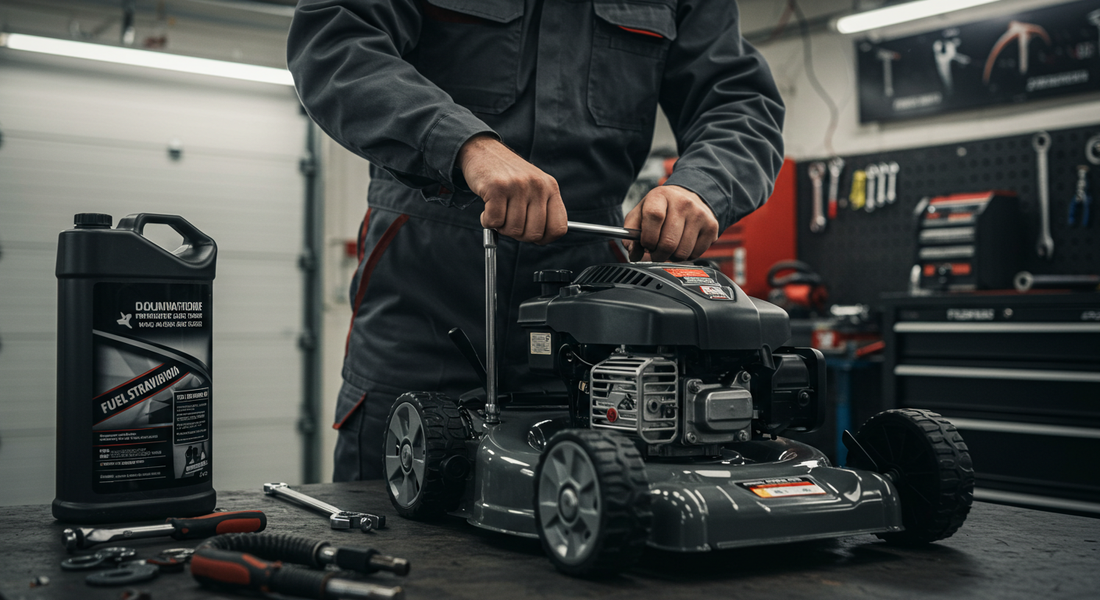
How to Winterize Your Lawn Mower and Other Gas-Powered Equipment
Share

As the final leaves fall and the gardening season comes to a close, it's tempting to simply roll your lawn mower into the shed and forget about it until spring. But a little work now will save you from a massive headache (and a potentially expensive repair bill) next year.
Proper winter storage is crucial for the health of any small gas-powered engine, whether it's in your lawn mower, string trimmer, or leaf blower. This guide will walk you through the essential steps on how to winterize a lawn mower and other equipment.
Step 1: The Fuel System
This is the single most critical step in small engine maintenance for winter storage. Old gasoline can wreak havoc on an engine.
-
Use a Fuel Stabilizer: Over a few months, the ethanol in gasoline can absorb water, and the fuel itself can gum up, clogging the carburetor and fuel lines. A gas stabilizer for winter is a chemical you add to the fuel that prevents this breakdown. Fill your gas tank almost to the top (leaving a little room for expansion), add the recommended amount of fuel stabilizer, and then run the engine for about 5-10 minutes. This allows the stabilized fuel to circulate through the entire system.
-
Run it Dry vs. Leave it Full:
-
Full Tank (with stabilizer): This is the most common and recommended method. A full tank prevents moisture from condensing inside the tank, which can lead to rust.
-
Run it Dry: The alternative is to run the engine until it is completely out of fuel. This ensures there's no gas left to go bad, but it can leave the carburetor's seals and gaskets prone to drying out and cracking over time.
-
Step 2: Cleaning
Storing a dirty machine is a recipe for rust and corrosion.
-
Clean the Deck and Engine: Disconnect the spark plug first for safety. Tip the mower on its side (with the carburetor and air filter facing up) and use a putty knife and a stiff brush to scrape away all the caked-on grass clippings from the underside of the deck. Wet grass holds moisture and will cause the deck to rust over the winter. Use a cloth or compressed air to clean any dirt and grime from the engine housing.
-
Why it Matters: A clean machine not only prevents rust but also runs cooler and more efficiently in the spring, as the engine's cooling fins are clear of debris.
Step 3: The Oil Change
Old, used oil contains contaminants that can be corrosive to engine parts over a long storage period.
-
Change Before Storage: It's always best to change the oil before you store your equipment, not after. Run the engine for a few minutes to warm the oil, which will help it drain more completely.
-
Simple Oil Change Guide: Place a drain pan under the mower, remove the drain plug, and let the old oil drain out. Replace the plug and refill the engine with the type and amount of oil recommended in your owner's manual.
Step 4: Spark Plugs and Blades
These final tune-up steps will ensure you're ready to go on the first day of spring.
-
Remove the Spark Plug: Disconnecting the spark plug is a crucial safety step before doing any work on the blade or deck. For extra engine protection, you can pour a small amount of engine oil into the cylinder, slowly pull the starter cord to distribute it, and then replace the spark plug.
-
Sharpen the Mower Blade: A sharp blade makes a clean cut, which is healthier for your grass. Now is the perfect time to remove the mower blade and have it sharpened so it's ready for the first mow of spring.
Step 5: Proper Storage
Where and how you store your equipment matters.
-
Find a Clean, Dry Location: The ideal spot for storing gas powered tools is a dry, protected location like a garage or a shed.
-
Use a Cover: Use a breathable cover to protect your equipment from dust, debris, and moisture. Avoid using a non-breathable plastic tarp, as this can trap moisture and lead to condensation and rust.
Conclusion: Your Equipment Will Thank You
Taking an hour or two to properly winterize your gas-powered tools is one of the smartest investments you can make as a homeowner. When spring arrives, you won't be faced with a frustrating, sputtering engine. Instead, your well-maintained equipment will start right up, ready for another season of hard work.
